Abstract
A total of 359 hemolytic Escherichia coli strains, representing eight pig pathogenic serotypes and isolated from pigs with enteric disease, was tested for transferable resistance to eight antibiotics. The co-transfer of plasmids controlling hemolysin production (Hly) with antibiotic resistance plasmids (R-factors) was evaluated. Transferable resistance to tetracycline, streptomycin, and/or sulfonamides was found in 47% of the total number of strains and 80% of the resistant ones. Chloramphenicol resistance was seldom seen. Co-transfer of Hly with R-factors occurred in 22.5% of the strains, generally to a degree excluding a genetic linkage. Stable coexistence of two R-factors in a cell was indicated by transfer patterns in 29 of the strains.
Full text
PDF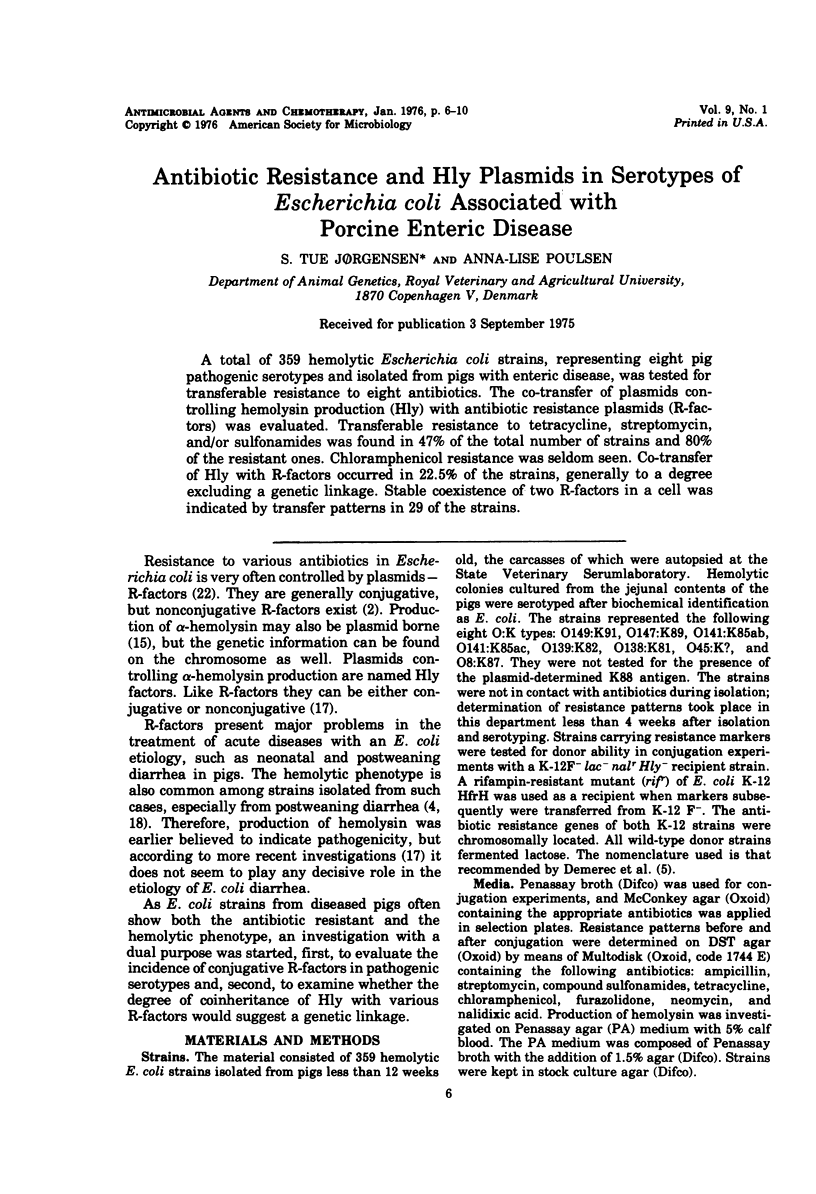
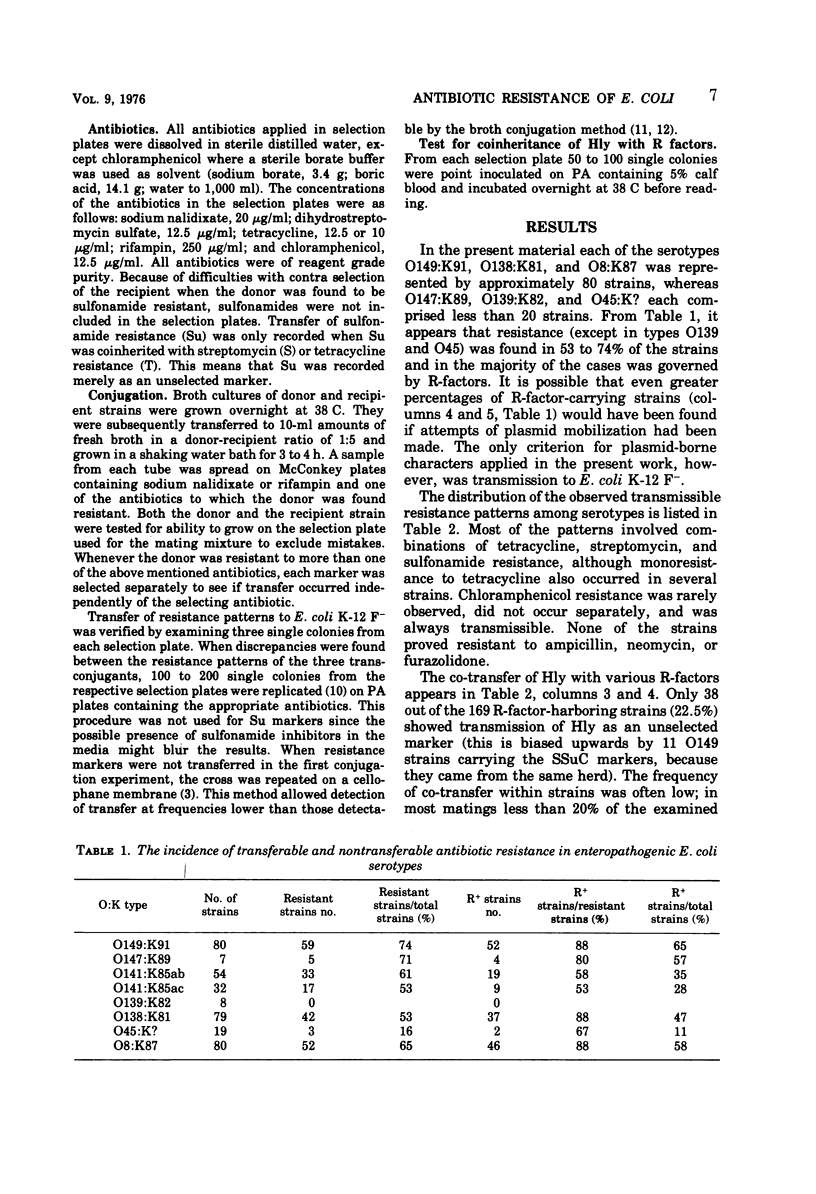
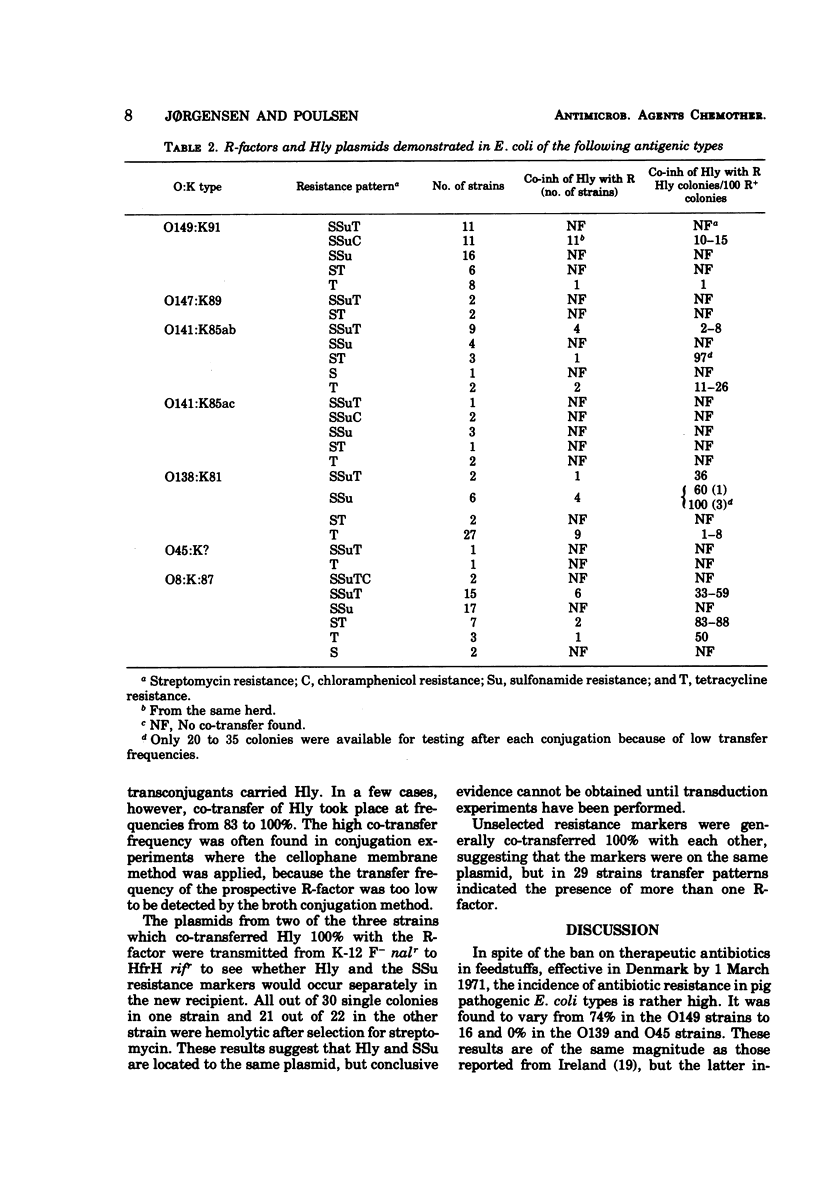
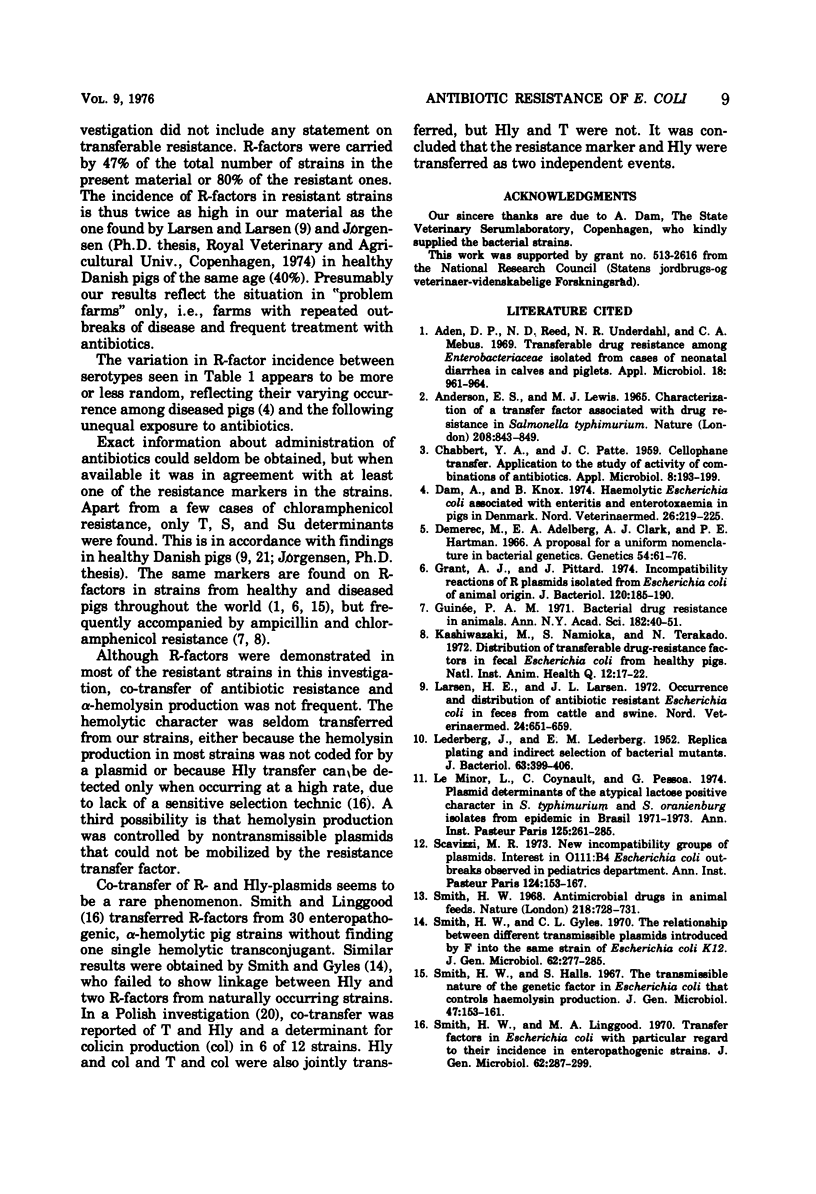
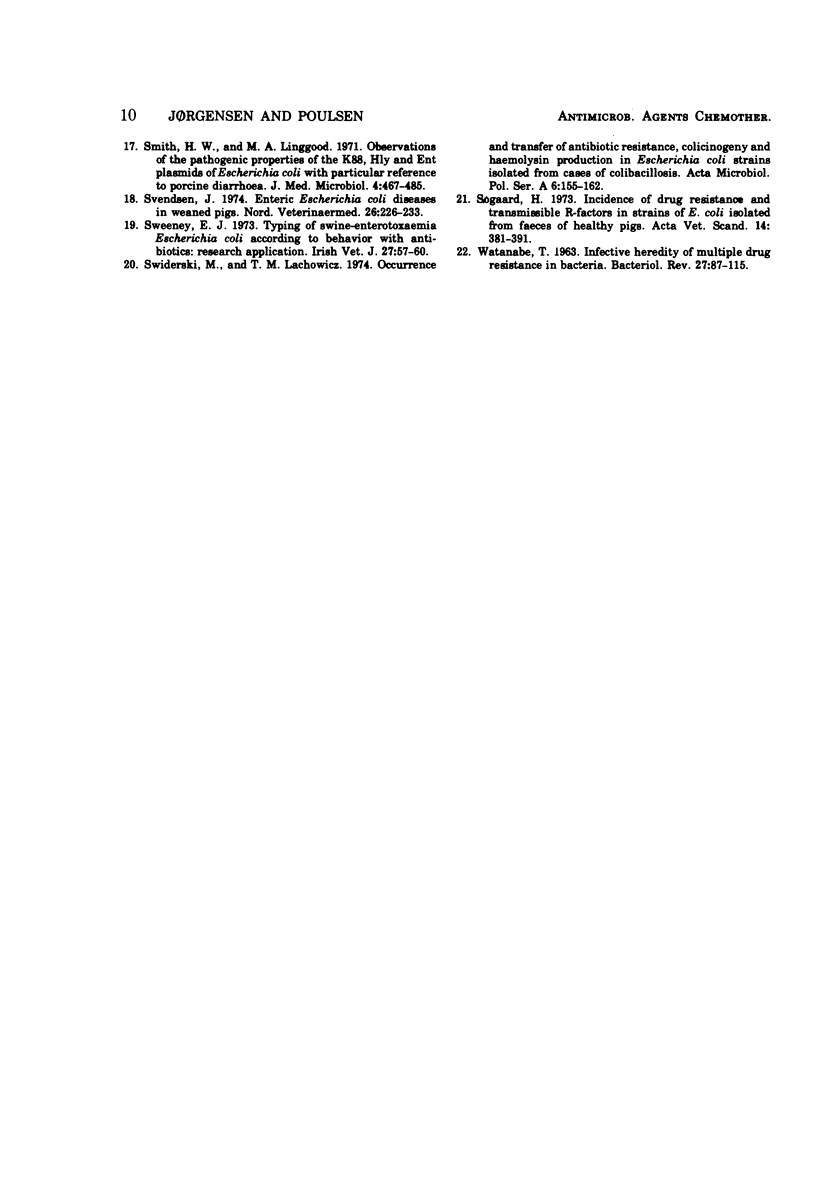
Selected References
These references are in PubMed. This may not be the complete list of references from this article.
- Aden D. P., Reed N. D., Underdahl N. R., Mebus C. A. Transferable drug resistance among Enterobacteriaceae isolated from cases of neonatal diarrhea in calves and piglets. Appl Microbiol. 1969 Dec;18(6):961–964. doi: 10.1128/am.18.6.961-964.1969. [DOI] [PMC free article] [PubMed] [Google Scholar]
- Anderson E. S., Lewis M. J. Characterization of a transfer factor associated with drug resistance in Salmonella typhimurium. Nature. 1965 Nov 27;208(5013):843–849. doi: 10.1038/208843a0. [DOI] [PubMed] [Google Scholar]
- CHABBERT Y. A., PATTE J. C. Cellophane transfer: application to the study of activity of combinations of antibiotics. Appl Microbiol. 1960 Jul;8:193–199. doi: 10.1128/am.8.4.193-199.1960. [DOI] [PMC free article] [PubMed] [Google Scholar]
- Dam A., Knox B. Haemolytic Escherichia coli associated with enteritis and enterotoxaemia in pigs in Denmark, with particular reference to the rapid spread of serogroup 0149:K91. Nord Vet Med. 1974 Mar;26(3):219–225. [PubMed] [Google Scholar]
- Demerec M., Adelberg E. A., Clark A. J., Hartman P. E. A proposal for a uniform nomenclature in bacterial genetics. Genetics. 1966 Jul;54(1):61–76. doi: 10.1093/genetics/54.1.61. [DOI] [PMC free article] [PubMed] [Google Scholar]
- Grant A. J., Pittard J. Incompatibility reactions of R plasmids isolated from Escherichia coli of animal origin. J Bacteriol. 1974 Oct;120(1):185–190. doi: 10.1128/jb.120.1.185-190.1974. [DOI] [PMC free article] [PubMed] [Google Scholar]
- Guinée P. A. Prevalence of extrachromosomal drug resistance. Bacterial drug resistance in animals. Ann N Y Acad Sci. 1971 Jun 11;182:40–51. doi: 10.1111/j.1749-6632.1971.tb30641.x. [DOI] [PubMed] [Google Scholar]
- Kashiwazaki M., Namioka S., Terakado N. Distribution of transferable drug-resistance factors in fecal Escherichia coli from healthy pigs. Natl Inst Anim Health Q (Tokyo) 1972 Spring;12(1):17–22. [PubMed] [Google Scholar]
- LEDERBERG J., LEDERBERG E. M. Replica plating and indirect selection of bacterial mutants. J Bacteriol. 1952 Mar;63(3):399–406. doi: 10.1128/jb.63.3.399-406.1952. [DOI] [PMC free article] [PubMed] [Google Scholar]
- Larsen H. E., Larsen J. L. Forekomst og udbredelse af antibiotikaresistente Escherichia coli i faeces fra kvaeg og svin. Nord Vet Med. 1972 Dec;24(12):651–659. [PubMed] [Google Scholar]
- Le Minor L., Coynault C., Pessoa G. Déterminisme plasmidique du caractère atypique "lactose positif" de souches de S. typhi-murium et de S. oranienburg isolées au Brésil lors d'épidémies de 1971 à 1973. Ann Microbiol (Paris) 1974 Apr;125A(3):261–285. [PubMed] [Google Scholar]
- Smith H. W. Anti-microbial drugs in animal feeds. Nature. 1968 May 25;218(5143):728–731. doi: 10.1038/218728a0. [DOI] [PubMed] [Google Scholar]
- Smith H. W., Gyles C. L. The relationship between different transmissible plasmids introduced by F into the same strain of Escherichia coli K12. J Gen Microbiol. 1970 Aug;62(3):227–285. doi: 10.1099/00221287-62-3-277. [DOI] [PubMed] [Google Scholar]
- Smith H. W., Halls S. The transmissible nature of the genetic factor in Escherichia coli that controls haemolysin production. J Gen Microbiol. 1967 Apr;47(1):153–161. doi: 10.1099/00221287-47-1-153. [DOI] [PubMed] [Google Scholar]
- Smith H. W., Linggood M. A. Observations on the pathogenic properties of the K88, Hly and Ent plasmids of Escherichia coli with particular reference to porcine diarrhoea. J Med Microbiol. 1971 Nov;4(4):467–485. doi: 10.1099/00222615-4-4-467. [DOI] [PubMed] [Google Scholar]
- Smith H. W., Linggood M. A. Transfer factors in Escherichia coli with particular regard to their incidence in enteropathogenic strains. J Gen Microbiol. 1970 Aug;62(3):287–299. doi: 10.1099/00221287-62-3-287. [DOI] [PubMed] [Google Scholar]
- Sogaard H. Incidence of drug resistance and transmissible R factors in strains of E. coli isolated from faeces of healthy pigs. Acta Vet Scand. 1973;14(3):381–391. doi: 10.1186/BF03547426. [DOI] [PMC free article] [PubMed] [Google Scholar]
- Svendsen J. Enteric Escherichia coli diseases in weaned pigs. Nord Vet Med. 1974 Mar;26(3):226–238. [PubMed] [Google Scholar]
- Swiderski M., Lachowicz T. M. Occurrence and transfer of antibiotic resistance, colicinogeny and haemolysin production in Escherichia coli strains isolated from cases of colibacillosis. Acta Microbiol Pol A. 1974;6(2):155–162. [PubMed] [Google Scholar]
- WATANABE T. Infective heredity of multiple drug resistance in bacteria. Bacteriol Rev. 1963 Mar;27:87–115. doi: 10.1128/br.27.1.87-115.1963. [DOI] [PMC free article] [PubMed] [Google Scholar]


